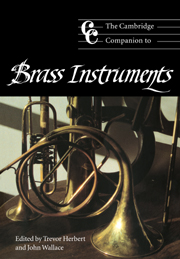Book contents
- Frontmatter
- Introduction
- 1 Lip-vibrated instruments of the ancient and non-western world
- 2 How brass instruments work
- 3 Design, technology and manufacture before 1800
- 4 Brass instruments in art music in the Middle Ages
- 5 The cornett
- 6 ‘Sackbut’: the early trombone
- 7 The trumpet before 1800
- 8 The horn in the Baroque and Classical periods
- 9 Design, technology and manufacture since 1800
- 10 Keyed brass
- 11 The low brass
- 12 Brass in the modern orchestra
- 13 Brass bands and other vernacular brass traditions
- 14 Playing, learning and teaching brass
- 15 The post-classical horn
- 16 Jazz, improvisation and brass
- 17 Brass solo and chamber music from 1800
- 18 Frontiers or byways? Brass instruments in avant-garde music
- Glossary
- Notes
- Select bibliography
- Index
10 - Keyed brass
Published online by Cambridge University Press: 28 September 2011
- Frontmatter
- Introduction
- 1 Lip-vibrated instruments of the ancient and non-western world
- 2 How brass instruments work
- 3 Design, technology and manufacture before 1800
- 4 Brass instruments in art music in the Middle Ages
- 5 The cornett
- 6 ‘Sackbut’: the early trombone
- 7 The trumpet before 1800
- 8 The horn in the Baroque and Classical periods
- 9 Design, technology and manufacture since 1800
- 10 Keyed brass
- 11 The low brass
- 12 Brass in the modern orchestra
- 13 Brass bands and other vernacular brass traditions
- 14 Playing, learning and teaching brass
- 15 The post-classical horn
- 16 Jazz, improvisation and brass
- 17 Brass solo and chamber music from 1800
- 18 Frontiers or byways? Brass instruments in avant-garde music
- Glossary
- Notes
- Select bibliography
- Index
Summary
The late eighteenth and early nineteenth centuries provided warm ground for the seeds of experimentation in brass instrument technology. Serpents and their latter-day relatives, the bass horns and basson russe, were proof that vented brasses were viable musical instruments. The need for fully chromatic brass increased as performers, instrument makers and audiences felt the need to find instruments that would suit the new music. A distinctly different sort of brass musician produced that music. For example, the training of Anton Weidinger as a guild apprentice serves in sharp contrast to the democratic self-instruction exemplified by the careers of the keyed bugle and ophicleide players that followed him.
Early keyed horns and trumpets
Ferdinand Kölbel and his son-in-law, Hensel, were the earliest documented experimenters with keyed horns, which they called the Amor-Schall. In 1756, they demonstrated two of their instruments for Tsarina Katharina II in St Petersburg. Kölbel's instrument had keys on the bell and on a cross tube. The instrument featured a unique bell in the form of a half sphere. A second half of the sphere with perforations to let the sound out could be attached to this section, and it was the special sound that made the name Amor-Schall appropriate. The instrument had a sound that was, according to one account, ‘a very agreeable blend, from the normal hunting horn, English horn, and the oboe’. The instrument employed a new technique, produced a sound that varied from the mainstream, was difficult to manufacture and attracted few disciples. Horn players preferred the hand-stopping techniques that were already established and widely accepted.
- Type
- Chapter
- Information
- The Cambridge Companion to Brass Instruments , pp. 131 - 142Publisher: Cambridge University PressPrint publication year: 1997



